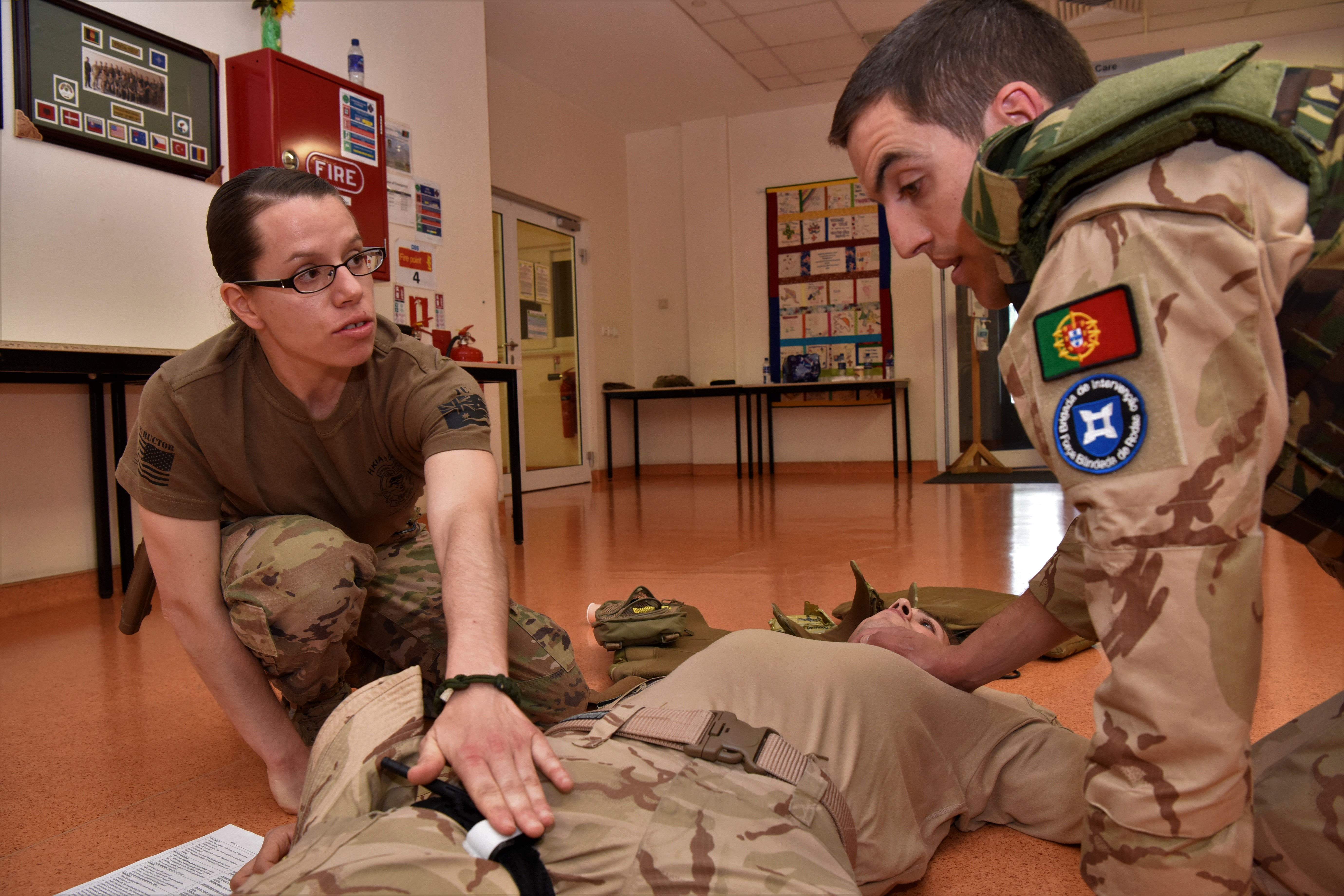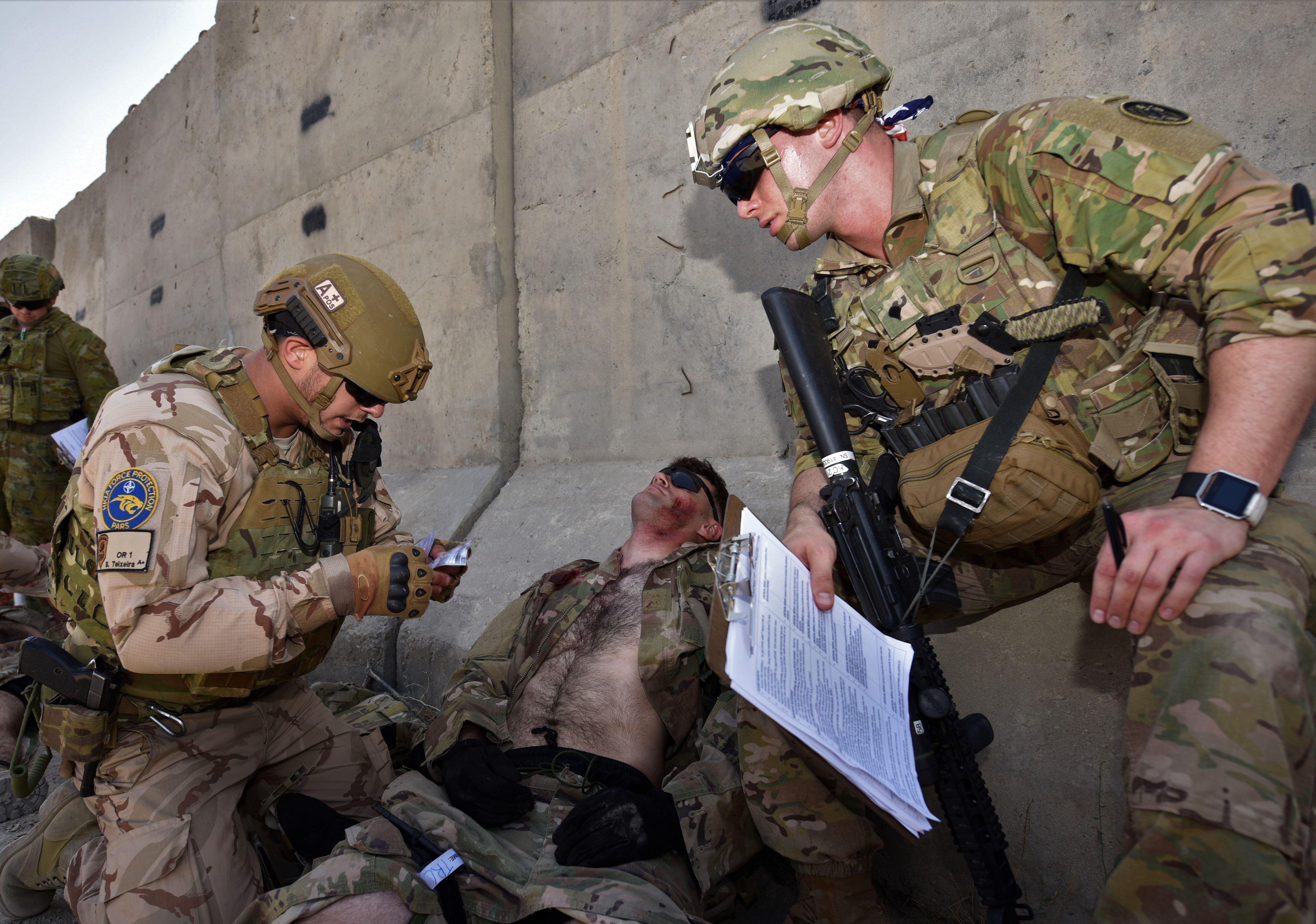Saving Lives through Tactical Combat Casualty Care
[vc_row 0=””][vc_column 0=””][vc_column_text 0=””]By Master Sgt. Felix Figueroa, NATO Special Operations Component Command-Afghanistan Public Affairs
[/vc_column_text][vc_column_text 0=””]

Capt. Michelle L. Levesque, a Tactical Combat Casualty Care trainer from the 224th Medical Company, Maryland National Guard, explains the importance of rechecking tourniquet placement after moving a casualty during TCCC training.
KABUL, Afghanistan – The U.S. and NATO service members assigned to Hamid Karzai International Airport’s Role 2 hospital, a NATO hospital, recently spent their spare time training Force Protection service members in the art of Tactical Combat Casualty Care.
“Military medics are in high demand and limited,” said Capt. Michelle Levesque, a U.S. Army TCCC training officer from the 224th Medical Company assigned to the HKIA hospital. “Therefore, TCCC training for non-medical personnel is not only important; it’s critical.”
Levesque, a hand surgery specialty physician’s assistant in Baltimore, Maryland, has dealt with a wide range of medical emergencies, from gunshot wounds to complete amputations and other upper extremity traumas. She said her civilian experiences, coupled with her military training, enable her to plan, oversee and implement realistic combat-based TCCC training.
“The goal of TCCC is to identify and treat those casualties with preventable causes of death and keep them alive long enough to reach a hospital,” Levesque added.
Levesque said that during her time at HKIA’s Role 2 hospital, she and her team provided TCCC training every month to local service members, along with diverse groups such as Force Protection, Train Assist Advise Command-Air, and Security Force Assistance Brigade.
“From a medical provider stand-point, equipping other soldiers with pre-hospital lifesaving skills that can be readily used prior to medical personnel arriving on-scene provides a force multiplier aspect into any deployment setting,” said Levesque.
Those participating in the third iteration of TCCC training learned and were tested on several skills including treating severe bleeding, tourniquet application, clearing and protecting the airway, treatment for penetrating chest wounds, and on-scene safety.
After two days of classroom hands-on learning and step-by-step instructions, students donned body armor and tested their skills in a short field exercise, moving as a unit through a training village within the base. Hospital staff acted as enemy role-players and ambushed the TCCC students. The students were required to establish security measures, conduct follow-on casualty assessments, and move to a casualty collection point where they were assessed on their newly acquired life-saving skills.

A Portuguese Force Protection soldier, a TCCC student, provides his evaluator, U.S. Army Spc. Bradley Boucher, 224th Medical Company, Maryland National Guard, with a nine-line report for the evacuation of a simulated casualty he stabilized during the TCCC field exercise.
“Although this is my first deployment as medic, I am an EMT and firefighter back home in Annapolis,” said Spc. Bradley Boucher, a 224th Med. Co. medic assigned to the hospital who served as an instructor for the TCCC training. “I know all too well what it takes to get through a surreal and life-threatening situation.”
Boucher used his experience in his civilian job to emphasize to students the importance of controlling blood loss. He told his students about one of his first calls as an EMT where one of his patients died from a gunshot wound due to severe bleeding on the way to the hospital.
While instructing the students, Boucher recalled one of his first calls as an EMT to emphasize the importance of controlling blood loss. One of his patients died from a gunshot wound due to severe bleeding on the way to the hospital.
Another instructor, who has deployed multiple times to Afghanistan, recalled his experiences as a Romanian Special Forces nurse to illuminate lessons for TCCC students on their first deployment.
“I’ve experienced my fair share of action against anti-Afghan government forces, witnessing many battlefield related wounds and injuries,” said Ionut Amnar, a Senior Non-Commissioned Officer (OR-7) and Romanian Special Forces nurse at the HKIA Role 2 hospital. “As a result, I stress to TCCC students the importance of stopping catastrophic bleeding, clearing and securing the airway, and respiration management.”
“The training provided to our NATO partners is designed to empower them, increase situational awareness and ensure survivability while out on missions,” said HKIA Role 2 Hospital commander Capt. Anne Alvarado, 224th Med. Co. “TCCC training provides all of that, along with peace of mind through confidence, knowing you can save a life.”[/vc_column_text][/vc_column][/vc_row]
